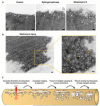Damage control: cellular mechanisms of plasma membrane repair
- PMID: 25150593
- PMCID: PMC4252702
- DOI: 10.1016/j.tcb.2014.07.008
Damage control: cellular mechanisms of plasma membrane repair
Abstract
When wounded, eukaryotic cells reseal in a few seconds. Ca(2+) influx induces exocytosis of lysosomes, a process previously thought to promote repair by 'patching' wounds. New evidence suggests that resealing involves direct wound removal. Exocytosis of lysosomal acid sphingomyelinase (ASM) triggers endocytosis of lesions followed by intracellular degradation. Characterization of injury-induced endosomes revealed a role for caveolae, sphingolipid-enriched plasma membrane invaginations that internalize toxin pores and are abundant in mechanically stressed cells. These findings provide a novel mechanistic explanation for the muscle pathology associated with mutations in caveolar proteins. Membrane remodeling by the ESCRT complex was also recently shown to participate in small-wound repair, emphasizing that cell resealing involves previously unrecognized mechanisms for lesion removal that are distinct from the patch model.
Keywords: caveolae; endocytosis; injury; muscular dystrophy; resealing.
Copyright © 2014 Elsevier Ltd. All rights reserved.
Figures




References
-
- Heilbrunn L. The dynamics of living protoplasm. Academic Press; 1956.
-
- Chambers R, Chambers E. Explorations into the nature of the living cell. Harvard University Press; 1961.
-
- McNeil PL, et al. Patching plasma membrane disruptions with cytoplasmic membrane. J Cell Sci. 2000;113:1891–1902. - PubMed
Publication types
MeSH terms
Substances
Grants and funding
LinkOut - more resources
Full Text Sources
Other Literature Sources
Miscellaneous

